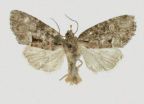(Press-News.org) A small, drab and highly inconspicuous moth has been flitting nameless about its special niche among the middle elevations of one of the world's oldest mountain ranges, the southern Appalachian Mountains in North America. A team of American scientists has now identified this new to science species as Cherokeea attakullakulla and described it in a special issue of the open access journal ZooKeys.
In all probability, it has been frequenting these haunts for tens of millions of years before the first humans set foot on this continent, all the while not caring in the least that it had no name or particular significance.
Among the first humans to occupy those misty ridges now called the Great Smoky Mountains in what is today western North Carolina and eastern Tennessee were not Europeans, but native Americans, and they called themselves the Cherokee. It seems unlikely they had a name for this particular small creature, or distinguished it from tens of thousands of other insect species which constitute only a portion of the fauna and flora of this richly endowed region, but they shared their new home with it, and lived in harmony with all the creatures of the Appalachian forest.
In 1958 a professor from Cornell University, Dr. John G. Franclemont, was studying some of the insects he collected at the Highlands Biological Station in Macon County, North Carolina and recognized one or two specimens as something different. None were seen again for four decades until Dr. J. Bolling Sullivan III, now a retired biologist formerly working with the Duke University Marine Lab in Beaufort, North Carolina, encountered numbers of this same insect while conducting biological inventories in the mountainous regions of the western part of the state.
Recently he teamed up with Eric Quinter, a retired entomologist from the American Museum of Natural History in New York City, who for several decades has been studying the group of moths to which this species belongs. Eric's intensive work in the southeastern United States focused on a unique habitat there, called canebrakes. He has revealed the presence of at least two dozen species of moths and butterflies, many unknown to science, whose caterpillars either exclusively feed upon or are associated with the native bamboo species constituting these canebrakes.
The result: in 2014 this little moth finally has an epithet even larger than itself – Cherokeea attakullakulla – named to honor the Cherokee Nation, whose members were exemplary stewards of the habitats and resources of the region, and also to honor one of their most revered leaders, Chief Attakullakulla, who in 1730 travelled to London and throughout the Carolinas to represent his peoples in the negotiation of various treaties.
"Fortunately, today much of this wondrous place and its extraordinarily diverse biota remains preserved as the Great Smoky Mountains National Park, and the memory of those who first settled there remains immortalized in a tiny creature oblivious to it all." comments Dr. Eric Quinter.
INFORMATION:
Original Source:
Quinter EL, Sullivan JB (2014) A new apameine genus and species from the southern Appalachian Mountains, USA (Lepidoptera, Noctuidae, Noctuinae). In: Schmidt BC, Lafontaine JD (Eds) Contributions to the systematics of New World macro-moths V. ZooKeys 421: 181. doi: 10.3897/zookeys.421.7727
A new species of moth from the Appalachian Mountains named to honor the Cherokee Nation
2014-06-27
ELSE PRESS RELEASES FROM THIS DATE:
Kids who know unhealthy food logos more likely to be overweight
2014-06-27
The more a child is familiar with logos and other images from fast-food restaurants, sodas and not-so-healthy snack food brands, the more likely the child is to be overweight or obese.
And, unfortunately, studies have shown that people who are overweight at a young age, tend to stay that way.
A research team that included a Michigan State University professor tested kids on their knowledge of various brands – including their ability to identify items such as golden arches, silly rabbits and a king's crown – and found that those who could identify them the most tended ...
'Compressive sensing' provides new approach to measuring a quantum system
2014-06-27
In quantum physics, momentum and position are an example of conjugate variables. This means they are connected by Heisenberg's Uncertainty Principle, which says that both quantities cannot be simultaneously measured precisely. Recently, researchers have been developing novel techniques, such as "weak measurement," to measure both at the same time. Now University of Rochester physicists have shown that a technique called compressive sensing also offers a way to measure both variables at the same time, without violating the Uncertainty Principle.
In a paper published in ...
Developmental psychologist explains her life's work studying the mysteries of the mind
2014-06-27
HAMILTON, ON, June 27, 2014—Developmental psychologist Daphne Maurer has spent more than four decades studying the complexities of the human mind.
As the director of the Visual Development Lab at McMaster University and president of the International Society on Infant Studies, Maurer will present her life's work at the Biennial International Conference on Infant Studies in Berlin July 4th.
Over the course of her career she has established a reputation for building new understanding of one of the most challenging and mysterious aspects of human development: how our ...
Monkeys also believe in winning streaks, study shows
2014-06-27
Humans have a well-documented tendency to see winning and losing streaks in situations that, in fact, are random. But scientists disagree about whether the "hot-hand bias" is a cultural artifact picked up in childhood or a predisposition deeply ingrained in the structure of our cognitive architecture.
Now in the first study in non-human primates of this systematic error in decision making, researchers find that monkeys also share our unfounded belief in winning and losing streaks. The results suggests that the penchant to see patterns that actually don't exist may be ...
EARTH Magazine: Rosetta off to decipher a comet's secrets
2014-06-27
Alexandria, Va. — "Hello World." Upon hearing that brief message, scientists at the European Space Agency (ESA) and followers around the world sent up a collective cheer. Rosetta — the ESA spacecraft currently on a 10-year mission to orbit and land on a comet — awoke in January after a three-year hibernation, and was ready to get to work.
The Rosetta spacecraft launched on March 2, 2004, to study Comet 67P/Churyumov-Gerasimenko. In August, Rosetta will enter the comet's orbit. By November, scientists will plant a lander on the comet, in the hope of learning more about ...
Early life stress can leave lasting impacts on the brain
2014-06-27
MADISON, Wis. — For children, stress can go a long way. A little bit provides a platform for learning, adapting and coping. But a lot of it — chronic, toxic stress like poverty, neglect and physical abuse — can have lasting negative impacts.
A team of University of Wisconsin-Madison researchers recently showed these kinds of stressors, experienced in early life, might be changing the parts of developing children's brains responsible for learning, memory and the processing of stress and emotion. These changes may be tied to negative impacts on behavior, health, employment ...
Are conservatives more obedient and agreeable than their liberal counterparts?
2014-06-27
Over the last few years, we've seen increasing dissent among liberals and conservatives on important issues such as gun control, health care and same-sex marriage. Both sides often have a difficult time reconciling their own views with their opposition, and many times it appears that liberals are unable to band together under a unifying platform. Why do conservatives appear to have an affinity for obeying leadership? And why do conservatives perceive greater consensus among politically like-minded others? Two studies publishing in Personality and Social Psychology Bulletin ...
Extinct undersea volcanoes squashed under Earth's crust cause tsunami earthquakes, according to new research
2014-06-27
New research has revealed the causes and warning signs of rare tsunami earthquakes, which may lead to improved detection measures.
Tsunami earthquakes happen at relatively shallow depths in the ocean and are small in terms of their magnitude. However, they create very large tsunamis, with some earthquakes that only measure 5.6 on the Richter scale generating waves that reach up to ten metres when they hit the shore.
A global network of seismometers enables researchers to detect even the smallest earthquakes. However, the challenge has been to determine which small ...
Climate change and the ecology of fear
2014-06-27
Climate change is predicted to have major impacts on the many species that call our rocky shorelines home. Indeed, species living in these intertidal habitats, which spend half their day exposed to air and the other half submerged by water, may be subjected to a double whammy as both air and water temperatures rise. Given the reliance of human society on nearshore coastal ecosystems, it is critical that we better understand how climate change will affect them.
In a recent study published in Global Change Biology, Northeastern University professor Geoffrey C. Trussell, ...
New report evaluates progress of comprehensive everglades restoration plan
2014-06-27
WASHINGTON – Although planning for Everglades restoration projects has advanced considerably over the past two years, financial, procedural, and policy constraints have impeded project implementation, says a new congressionally mandated report from the National Research Council. Timely authorization, adequate funding levels, and creative policy and implementation strategies are needed to achieve restoration benefits and to expedite implementation of the Central Everglades Planning Project. Climate change and the invasion of nonnative plant and animal species further challenge ...



